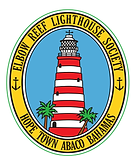
ELBOW REEF LIGHTHOUSE SOCIETY

The Most Recognized Landmark in Abaco and the Last Light of its Kind in The World!

HISTORY est. 1864

Wrecks abounded throughout the Bahamas in the early nineteenth century, and concerned shipping interests implored the British Imperial Lighthouse Service in London, to increase the navigational aids in their colonies.
In 1836, they built major lighthouses at Hole-in-the-wall on the southern tip of Abaco and at Gun Cay, just south of Bimini, and in 1864 the lightstaton at Hope Town was erected.
When first built, the Elbow Reef Lighthouse showed a fixed light, that is, one that did not flash but shone a steady white light. By 1936, the Imperial Lighthouse Service saw the need for a light which could be more easily identified by ships at sea. Thus the Elbow Reef Lighthouse was given a major refit, using the lens and turning mechanism which had been at the Gun Cay Lighthouse. The fixed light was replaced by a rotating first-order Fresnel lens (pronounced "Frenel") with a unique character described on the nautical charts as, "GP FL W (5) EV 15 SEC 120FT 15M". That translates to a group of five white flashes every fifteen seconds, 120 feet above sea level with a visibility of fifteen nautical miles.
The lens and turning equipment in this lighthouse, made in the early 1900s by Chance Brothers of Birmingham, England, is still in place today, working beautifully. The lighting source is a 325,000 candlepower "Hood" petroleum vapour burner. A hand pump is used to pressurize the petroleum (kerosene) in the heavy green iron containers below the lantern room. The fuel travels up a tube to a vaporizer which sprays into a preheated mantle. Pressurized camping lanterns operate similarly. The beautiful Fresnel lens with its five "bull's-eyes" concentrate the mantle's light into piercing beams straight out towards the horizon, instead of up and down and all around, as in a camp lantern.


The lens itself with its brass work, bull's eyes and additional prisms weighs about three or four tons and floats in a circular tub containing about 1,200 pounds of mercury or "quicksilver". This reduces the friction, which would otherwise be caused by wheels or rollers. Weights, when wound up to the top of the tower by a hand winch, are able to, through a series of bronze gears, rotate the heavy apparatus, once every 15 seconds. It works like a large grandfather or cuckoo clock, and the keeper on duty has to wind up the weights every two hours. The 19th century system operates totally without electricity and runs very smoothly, at that. Thanks to its dedicated keepers, the Elbow Reef Lighthouse continues to shine exactly as it has every night for almost 80 years.
In 1953, The Imperial Lighthouse Service determined that the cracks caused by lightning to the brick tower were threatening its integrity and another major rebuilding process began. Engineers from England's Trinity House poured concentric rings of concrete in steps around the previously smooth tapering brick tower, making it noticeably wider. The brick tower is 89 feet high and there are 101 steps to the lantern room.

Bahamian Lighthouses have been operated by the Port Department since our Independence from Great Britain in 1973. The traditional hand-powered technology in this lighthouse is maintained by The Elbow Reef Lighthouse Society.
-Researched by Dave Gale
